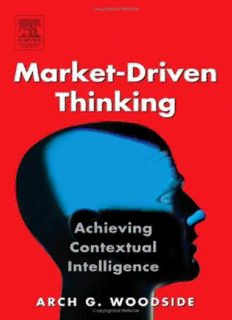
Market-Driven Thinking: Achieving Contextual Intelligence PDF
Preview Market-Driven Thinking: Achieving Contextual Intelligence
MARKET-DRIVEN THINKING Achieving Contextual Intelligence Arch G.Woodside Professor of Marketing Boston College Boston,Massachusetts AMSTERDAM ●BOSTON ●HEIDELBERG ●LONDON NEW YORK ●OXFORD ●PARIS ●SAN DIEGO SAN FRANCISCO ●SINGAPORE ●SYDNEY ●TOKYO Elsevier Butterworth–Heinemann 30 Corporate Drive,Suite 400,Burlington,MA 01803,USA Linacre House,Jordan Hill,Oxford OX2 8DP,UK Copyright © 2005,Elsevier Inc.All rights reserved. No part ofthis publication may be reproduced,stored in a retrieval system,or transmitted inany form or by any means,electronic,mechanical,photocopying,recording,or otherwise,without the prior written permission ofthe publisher. Permissions may be sought directly from Elsevier’s Science & Technology Rights Department in Oxford,UK:phone:(+44) 1865 843830,fax:(+44) 1865 853333, e-mail:[email protected] may also complete your request on-line via the Elsevier homepage (http://elsevier.com),by selecting “Customer Support”and then “Obtaining Permissions.” (cid:1) Recognizing the importance ofpreserving what has been written,Elsevier prints its books on acid-free paper whenever possible. Library ofCongress Cataloging-in-Publication Data Woodside,Arch G. Market-driven thinking :achieving contextual intelligence / Arch G.Woodside. p.cm. Includes bibliographical references and index. ISBN 0-7506-7901-8 (alk.paper) 1. Marketing–Decision making. 2. Marketing–Psychological aspects. 3. Consumer behavior– Psychological aspects.I.Title. HF5415.135.W66 2005 658.8′342–dc22 2004028555 British Library Cataloguing-in-Publication Data A catalogue record for this book is available from the British Library. ISBN:0-7506-7901-8 For information on all Elsevier Butterworth–Heinemann publications visit our Web site at www.books.elsevier.com 05 06 07 08 09 10 11 10 9 8 7 6 5 4 3 2 1 Printed in the United States ofAmerica To my daughters, Christine Ann,Judith Beth,and Martha Jane Woodside CONTENTS PREFACE XI ACKNOWLEDGMENTS XIX I A PRIMER IN LEARNING MARKET-DRIVEN THINKING 1 Thinking,Deciding,and Acting by Executives and Customers 3 2 Case Study Research Methods for Learning How Executivesand Customers Think,Decide,and Act 17 3 Mapping Contingent Thinking by B2B Marketers and Customers 35 vii viii CONTENTS II TOOLS FOR ILLUMINATING THE UNCONSCIOUS AND CONSCIOUS MIND 4 Balanced and Unbalanced Unconscious–Conscious Thinking:A Jewish Couple Buys a German Car and AdditionalTransformation Stories 65 5 Advancing Understanding of Customers’Means–End Chains:Eric Drinks Twelve Cans of Beerand Talks to Girls 85 6 Advancing from Subjective to Confirmatory Personal Introspection 103 III CUSTOMER ASSOCIATE-TO-VENDOR (STORE) RETRIEVAL RESEARCH 7 Customer Automatic Thinking and Store Choice:Why Asking Customers to Think About a Named Store isa Mistake 129 8 Automatic Thinking and Vendor Choices by Customers of Industrial Distributors:Mapping Customers’Vendor Mind Positions 139 IV CASE-BASED RESEARCH FOR LEARNING GESTALT THINKING/DOING PROCESSES 9 Applying the Long Interview Method for Comparing Executive and CustomerThinking 163 10 Holistic Case-Based Modeling of Customers’ Thinking/Doing Brand Experiences 191 ix CONTENTS V LEARNING HOW INITIAL BEHAVIOR AFFECTS FUTURE BEHAVIOR 11 TheInfluences of Brand Imprinting and Short-Term Marketing on Subsequent Customer Choices 249 12 Customer Variety-Seeking Influence on Subsequent Brand Choice Behavior 265 REFERENCES 279 INDEX 293 PREFACE Meta-thinking,or thinking and research on thinking,includes three principal areas of inquiry: ● Descriptive research on how thinking and action occur and relate to each other. ● Prescriptive research on what steps and tools can be applied effectively to increase the quality of thinking. ● Normative research on how thinking should occur according to game theory and rational models of behavior. Humans are the only organisms who raise and attempt to answer the three principal questions that relate to these three areas: ● How do we actually go about thinking? ● How can we get better at thinking? ● What’s the best way to think given a particular context? This book focuses on examining the first question within the context of business-to-business (B2B) and business-to-consumer (B2C) marketplaces in xi
Description: